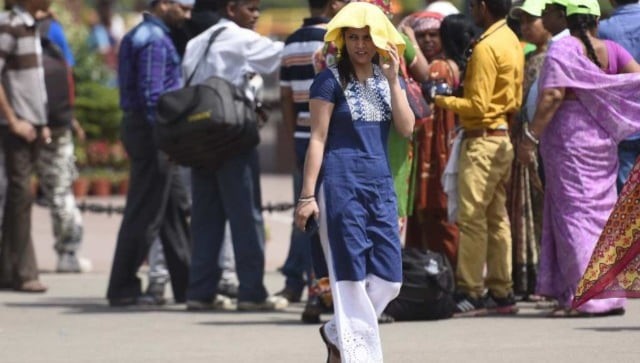
Why temperature touching 50°C in North India may be the new normal

As many parts of north India reeled under a heatwave with temperatures shooting up to an excess of 49 degrees Celsius (C°) on Sunday (May 15), experts felt that it was increasingly possible that temperatures can even touch 50°C; and that may be the new normal.
Events such as the 2022 heatwave are occurring more often and it’s now alright to expect unbelievable extreme weather events.
On Sunday, maximum temperatures in parts of Delhi rose above 49°C and other parts of northwest India also suffered from scorching temperatures.
Banda in Uttar Pradesh recorded 49°C; Gurugram, Hisar and Narnaul in Haryana; and Khajuraho and Nowgong in Madhya Pradesh recorded maximum temperatures of over 47°C. An ‘orange’ alert was also issued to caution people about a severe heatwave on Sunday.
One of the root causes of this increase in heatwaves is climate change, said climate scientists, who felt that people should now get used to these temperatures as they will become the norm.
M Rajeevan, former secretary, ministry of earth sciences told Hindustan Times that this is the new normal and it will remain so for years to come.
According to Rajeevan, maximum temperatures during heatwave periods over northwest India have already gone up from 45-46°C to 47-48°C. Due to climate change, we will witness three things with heatwaves: higher intensity; an increase in duration from, say, 5 days to 7-8 days at a stretch; and a larger impact area.
Also read: Heat wave, dust storms forecast in Punjab, Haryana, Rajasthan; Delhi to get mild relief
There were other factors that also played a role in triggering this climate crisis. According to news reports, the prolonged dry spell in northwest India and central India, combined with fewer western disturbances that bring pre-monsoon rain to northwest India were some of the other reasons for the heatwave.
Climate scientists said that the western disturbances – storms originating in the Mediterranean region – were less this year, which meant little pre-monsoon rainfall in north-western and central India reason usually resulted in clear skies and very high solar radiation. They also contributed to the heatwave.
Anti-cyclones, an area of high atmospheric pressure where the air sinks – also led to hot, dry weather over parts of western India in March.
Meanwhile, DS Pai, director at the Institute of Climate Change Studies, government of Kerala and former IMD scientist told the HT that atmospheric conditions were peculiar this year.
An area of high pressure which formed in March and centred around Gujarat, persisted in April, leading to the incursion of dry and hot north-westerlies inwards. He also said that the weakening severe cyclone Asani in May, which dragged the northwesterly winds had brought hot, dry winds inward.
According to the scientist, during La Nina (a cold current in the Pacific that is linked to cooler summers) years, they do not expect such heatwaves but this year was exceptional.
Also read: Heatwave in some parts, rainfall in others: Here’s how India’s weather will be this week
Experts probe the heatwave in India and Pakistan
The Imperial College in UK-led World Weather Attribution (WWA) initiative is a collaboration between climate scientists around the world (which includes IIT Delhi in India), who provide robust assessments on the role of climate change in the aftermath of the event. They are expected to submit the findings of their study on this year’s spring heatwave in India and Pakistan (in March and April) within the next fortnight.
According to these scientists, all heatwaves today bear the unmistakable and measurable fingerprint of global warming. WWA is expected to sum up how the climate crisis may have made such an unprecedented heatwave event in India and Pakistan possible.
The WWA scientists said in a workshop for journalists that there is only a one in a 100 chance of such a heatwave occurring every year. This event was rare because of the very large area that was affected; the long duration of the heatwave spell; and the very early onset of the heatwave during the spring season. The scientists said the spell affected all of northwest India, central India and even parts of east India.
WWA released a guide last week for journalists reporting on extreme weather and climate change. In that they had said that the temperatures that formerly constituted ‘extreme’ are now just unusual and temperatures which were previously all but impossible are the new definition of extreme.
It is not just the climate crisis that is creating heatwave spells is obvious but urbanisation, population density is also contributing to the problem.


